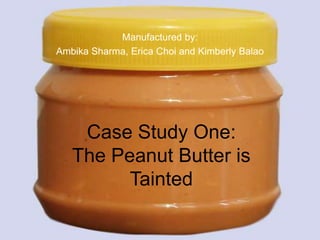
Case Study: The peanut butter is tainted
- 1. Manufactured by: Ambika Sharma, Erica Choi and Kimberly Balao Case Study One: The Peanut Butter is Tainted
- 2. Patient Situation: Symptoms Diarrhea Fever Abdominal Pains Lasts About 4-7 Days Some cases of Diarrhea was so bad that some had to be hospitalized. By the Numbers! 425 People from 44 States experienced these symptoms. Out of the 351 persons with clinical information, 71 of them had to be hospitalized.
- 3. Affected System DIGESTIVE SYSTEM!
- 4. Our Specific Patient: Experienced Stomach Cramping, Diarrhea, and Moderately High Temperature. Sixteen Hours Prior: He consumed a peanut butter sandwich. Could this be the answer to our patient’s problem? LET’S FIND OUT! We cultured our patient’s fecal matter to find the etiological agent of his illness.
- 5. Possible Culprits: 1. Escherichia coli(-) 2. Pseudomonas aeruginosa (-) 3. Salmonella enterica (-) 4. Staphylococcus aureus(+) 5. Streptococcus pyogenes (-) 6. Haemophilusinfluenzae (-)
- 7. Through methods of staining, we are able to conclude that our bacteria is gram (-)WE WILL BE USING MCONKEY AGAR as our differential media. http://www.youtube.com/watch?v=FWrjQoRcp1g&feature=channel_video_title
- 8. Staphylococcus aureus(+) Escherichia coli(-) Patient(-)
- 10. E. Coli was very pink in agar.
- 11. Why?: E. coli is capable of fermenting lactose in the agar.
- 12. Our patient had no bright pink color, we are looking for a gram (-) bacteria that is incapable of fermenting bacteria. http://www.youtube.com/watch?v=4BF5WsU7I6A
- 13. Possible Culprits: 1. Escherichia coli(-) 2. Pseudomonas aeruginosa (-) 3. Salmonella enterica (-) 4. Staphylococcus aureus(+) 5. Streptococcus pyogenes (+) 6. Haemophilusinfluenzae (-)
- 14. Salmonella Enterica Salmonella is a rod-shaped motile bacteria. This can be classified in the bacilli group of bacteria, and it has a flagella which makes it motile. Salmonella is arranged in a cluster-tetrad form which can be seen under a microscope. This bacteria has a unique way of infecting host cells, it uses a “syringe” technique in which it injects a protein called SipA. This protein essentially ruffles the outside of the cell, allowing the salmonella bacteria to enter and then replicate. Salmonella is an anaerobic bacteria that can survive under low Oxygen conditions
- 15. Epidemiology of Salmonella Enterica It can be found usually in food or water, and it affects the gastrointestinal region of humans Salmonella can also affect deeper parts of the human body like bone marrow due to their unique way of invading cells. Spread through the fecal-oral route (once excreted it in released into the environment and can infect it’s surrounding)
- 16. Salmonella Enterica Cont. Symptoms Salmonella, after it is ingested, produces hydrogen sulfide which causes the cells of the intestinal walls to become disorganized so that the the bacteria is engulfed The protein SipA then is injected into these cells via salmonella to “staple” actin filaments together and make curtain-like folds which allows it to engulf the bacteria It is then taken to the liver or the spleen. Salmonella has many evolved mechanisms that prevent our immune system from doing their job efficiently. Patient might have typhoid fever. This bacterium is a causative of typhoid fever. Symptoms include: Abdominal Cramps Vomiting Nausea Usually lasts up to seven days. How It Affects the Body
- 18. Results
- 19. Our Antibiotic Results: Chloramphenicol Gentamicin Penicillin Streptomycin Tetracyclin Vancomycin
- 20. Chloramphenicol A prototypical broad-spectrum antibiotic Bacteriostatic antimicrobial Inhibits growth of microorganisms Interfers with bacterial protein production, DNA replication, and several aspects of their cellular metabolism Effective against gram negative bacteria and anareobes
- 21. Preventative measures: Pay attention to cleanliness (proper cleaning) Proper cooking of food like poultry and meat Crack eggs with a knife and not on the bowl Scald eggs in boiling water Properly prepare fresh meats and vegetables
- 22. Real Salmonella Outbreaks! http://injurylawblog.the-injury-lawyer-directory.com/2011/03/10/skippy-peanut-butter-recalled-for-salmonella-contamination/